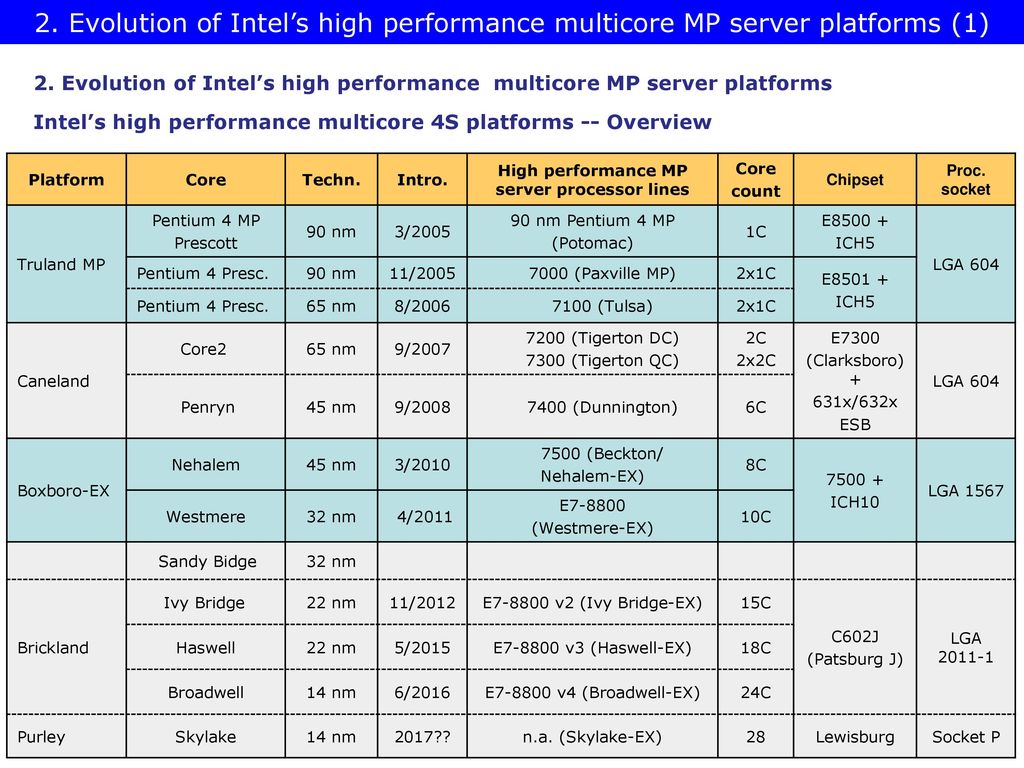- Evolution Of Intel Processors Pdf
- Evolution Of Intel Processor
- Evolution Of Intel Processor
- Evolution Of Intel Processors Family
- Evolution Of Intel Cpu
Sandy Bridge is the codename of the microarchitecture of processor developed by Intel. Intel demonstrated its first sandy bridge processors in 2009 and released in 2011 to replace its older processor named Nehalem. While Nehalem was based on 45 nm manufacturing technology, it uses planar double gate transistors. Evolution of intel computer processors It had 2, 300 transistors.This generational and chronological list of Intel processors attempts to present. Evolved from the capability processor developed for the BiiN joint venture with.Intels long-range vision for the evolution of these three eduardo bezerra uml pdf. Evolution of Intel Processor since 19th Century. Intel is the masterpiece in computer processor world. Intel Corporation founded on 18 July 1968. The most successful processors from Intel since 1993 are listed with rare unseen pictures. I do collected interesting unknown information about each processor. The 8086, also known as the iAPX 86, was Intel's first commercial 16-bit CPU and is considered to be the chip that launched the era of x86 processors. With 29,000 transistors built in a 3,000 nm.
Whether it’s a laptop or desktop PC, or a high-powered server, microprocessors are at the core of all types of computer hardware. The central processing unit (CPU) is the brain of a computer system, carrying out the number-crunching and input/output operations that are essential for software to function.
At Fasthosts, our Dedicated Servers sport powerful Intel processors to ensure optimum performance for your websites and applications. But if you’re looking for a certain level of power to match the needs of your project, it’s not always obvious which CPU is the best fit. Dual-core, quad-core, i3, i5, i7, Xeon – what do they all mean, and what are the benefits of each? And what about the various generations of Intel microarchitecture?
Generation X
Intel created the world’s first commercial microprocessors way back in the 1970s, based on the x86 instruction set architecture that, in some form, is still with us today. While microarchitecture concerns the design of the CPU itself, instruction set architecture defines the interface between the processor and the software. The widespread adoption of x86 is what enables chips from different manufacturers with different architectures to work in broadly the same way, allowing compatibility and interchangeability of computer parts.
Evolution Of Intel Processors Pdf

Of course, the first Intel processors were pitifully slow by today’s standards, and after 40 years of innovation modern CPUs are planet-sized supercomputers in comparison. Over that time Intel has gone through a host of model names and ‘families’ – you might remember the excitement of bringing home your first Pentium PC – and more recently the manufacturer has introduced catch-all ‘generations’ to define its latest microarchitecture.
There’s debate over the exact number of Intel generations, but the company itself recently announced its ‘7th Generation’ of Core processors. This doesn’t make them the seventh generation ever, but they are arguably the seventh generation of Intel’s Core family. Since ‘Nehalem’ in 2008, every generation has been assigned a codename, common to various CPU models that share the same architecture. This continued through Sandy Bridge, Ivy Bridge, Haswell, Broadwell, Skylake, and now Kaby Lake, each with their own advancements and new features.
Frequency? Cores? Threads? Cache?

There’s always been bewildering nomenclature around computer hardware, and processors are no exception. In the 1990s and early 2000s it was all about frequency or clock speed – how many clock cycles or calculations can be completed per second – with a higher frequency (measured in MHz or GHz) usually indicating better performance. But as time went on, it became clear that while higher clock speeds are always preferable, other, efficiency-boosting features are just as important.
Since the first generation of the Intel Core series, the number of processor cores has become a major performance indicator. Compared to older, single-core designs, multicore processors effectively function as two, four or even more separate CPUs. This allows a whole new level of multitasking, enabling computers to perform multiple intensive tasks at the same time, such as image rendering, gaming and background virus scans, while keeping performance as fast as possible. With the efficiency gains made by multicore architecture, many top-end single-core chips suddenly found themselves outperformed by dual-core processors with lower clock speeds.
A thread is a software term used by Intel in the context of its ‘Hyper-Threading Technology’ that refers to ‘the basic ordered sequence of instructions that can be passed through or processed by a single CPU core’. Hyper-Threading allows each core to run two threads instead of one, basically creating two virtual cores for each physical one to enable even more multitasking. While Hyper-Threading can’t provide as much extra performance as additional physical cores, it’s still a significant boost – and a server that combines multiple cores with Hyper-Threading is ideal for hosting high-demand applications.


The processor cache is a small amount of memory built into the CPU that copies frequently-used data from the main system RAM and stores it for fast access. Like clock speed and the number of cores and threads, it’s usually a safe bet that a bigger number equals better performance.
Core vs Xeon
The two big names in Intel’s current line-up are the Core range (Core i3, Core i5 and Core i7) and Xeon. Core is the Intel brand for mid to high-end processors for home and business users. While Core i3s usually have two cores, the latest i5s and i7s are quad-core CPUs, providing enhanced performance and multitasking.
Intel Xeon processors are aimed more at the professional workstation and server markets, with features that lend themselves to enterprise users rather than consumers. For example, top-end Xeons can support over 1TB RAM – not particularly relevant or practical for consumers, but potentially useful for large-scale server applications. The most powerful Xeons will also deliver more cores (up to 24) and a larger cache (up to 60 MB).
The short answer: quad-core Core i5s and i7s are more than enough for most small to medium business applications, but if your budget allows, you should definitely consider Xeon processors for more demanding server requirements. For a comprehensive resource detailing all currently available Intel CPUs, you can visit ark.intel.com.
If you’re still unsure which dedicated server setup is right for you, why not get in touch with our experts? They’ll be happy to talk you through our various packages and find the ideal configuration to ensure your sites and projects run smoothly. Just visit the Fasthosts website for details.
Evolution Of Intel Processor
The 4004 CPU was the forerunner of all of today’s Intel offerings and, to date, all PC processors have been based on the original Intel designs. The first chip used in an IBM PC was Intel’s 8088. This was not, at the time it was chosen, the best available CPU, in fact Intel’s own 8086 was more powerful and had been released earlier. The 8088 was chosen for reasons of economics: its 8-bit data bus required less costly motherboards than the 16-bit 8086.
Also, at the time that the original PC was designed, most of the interface chips available were intended for use in 8-bit designs. These early processors would have nowhere near sufficient power to run today’s software.
Evolution Of Intel Processor

Evolution Of Intel Processors Family
The table below shows the generations of processors from Intel’s first generation 8088/86 in the late 1970s to the eighth-generation AMD Athlon 64, launched in the autumn of 2003:
Evolution Of Intel Cpu
Chronological Evolution of CPUs
| Type/ Generation | Year | Data/ Address bus width | Level 1 Cache (KB) | Memory bus speed (MHz) | Internal clock speed (MHz) |
|---|---|---|---|---|---|
| 8088/ First | 1979 | 8/20 bit | None | 4.77-8 | 4.77-8 |
| 8086/ First | 1978 | 16/20 bit | None | 4.77-8 | 4.77-8 |
| 80286/ Second | 1982 | 16/24 bit | None | 6-20 | 6-20 |
| 80386DX/ Third | 1985 | 32/32 bit | None | 16-33 | 16-33 |
| 80386SX/ Third | 1988 | 16/32 bit | 8 | 16-33 | 16-33 |
| 80486DX/ Fourth | 1989 | 32/32 bit | 8 | 25-50 | 25-50 |
| 80486SX/ Fourth | 1989 | 32/32 bit | 8 | 25-50 | 25-50 |
| 80486DX2/ Fourth | 1992 | 32/32 bit | 8 | 25-40 | 50-80 |
| 80486DX4/ Fourth | 1994 | 32/32 bit | 8+8 | 25-40 | 75-120 |
| Pentium/ Fifth | 1993 | 64/32 bit | 8+8 | 60-66 | 60-200 |
| MMX/ Fifth | 1997 | 64/32 bit | 16+16 | 66 | 166-233 |
| Pentium Pro/ Sixth | 1995 | 64/32 bit | 8+8 | 66 | 150-200 |
| Pentium II/ Sixth | 1997 | 64/32 bit | 16+16 | 66 | 233-300 |
| Pentium II/ Sixth | 1998 | 64/32 bit | 16+16 | 66/100 | 300-450 |
| Pentium III/ Sixth | 1999 | 64/32 bit | 16+16 | 100 | 450-1.2GHz |
| AMD Athlon/ Seventh | 1999 | 64/32 bit | 64+64 | 266 | 500-2.2GHz |
| Pentium 4/ Seventh | 2000 | 64/32 bit | 12+8 | 400 | 1.4GHz-3.6GHz |
| AMD Athlon 64/ Eighth | 2003 | 64/64 bit | 64+64 | 400 | 2GHz-2.4GHz |